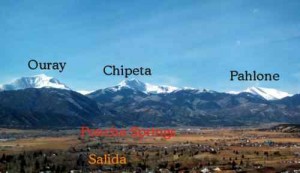Essay by John Mattingly
Sand Dunes – December 2004 – Colorado Central Magazine
MY HOME AND FARM are located about eight miles from the northwest boundary of the new Sand Dunes National Park and Wildlife Refuge. I opposed expansion of the Sand Dunes National Monument to a National Park, having a bias in favor of National Monuments. Monuments tend to be smaller, less crowded, primitive with services, and focused on a single natural feature. Parks are pretty much the opposite. It’s a personal preference: I would rather see more Monuments than existing Monuments supersized to Parks.
That, however, isn’t the only reason I opposed Parking the Dunes Monument. The expansion was not motivated entirely by the merits of the natural feature. The Dunes are remarkable, but not so remarkable that the U. S. Interior Department made a special, independent trip out here to Colorado to determine that the Dunes Monument should annex the Baca Ranch (cost to taxpayers about $32 million) and become a National Park.
No, that determination was driven by a couple of forces unrelated to nature, but sufficiently related to each other to make the expansion happen.
The first force was local/regional interests that wanted to “protect the Baca Ranch water rights” from the likes of AWDI (American Water Development, Inc.) and Stockman’s Water Company (Gary Boyce). The Baca Ranch has extensive surface and potential groundwater rights of proportions that have made it attractive to a series of water investment players.
Baca Ranch water investors met opposition from a formidable coalition of San Luis Valley activists: the Rio Grande Water Conservation District, every water conservancy or irrigation district in the Valley, conservation groups, environmental groups, individual farmers, and regional businesses. Being a water investor on the Baca Ranch has not been a popular occupation in the San Luis Valley during the last 20 years. Opposition to Baca Ranch water developers proved expensive and time-consuming to the opposition.
So, it is not surprising that a local/regional coalition of the willing gave rise to the second force: politicians seeking credit for “protecting Colorado water.” This phrase has broad appeal. It’s like being against crime or speaking well of your mother. Scott McInnis and Wayne Allard saw a political opportunity in supporting the coalition of local/regional activists and promoted the legislation through Congress.
The Dunes Monument personnel were in favor of a higher profile and bigger budget, and creation of a new National Park had currency in election year politics. So, the Sand Dunes Monument is now a National Park. Done deal.
HOWEVER, as a neighboring farmer to this new Park, I have four concerns about the deal:
1. This is not a legitimate role for government. A full register of laws and regulations already exist for the governance of water development and transfer activities in Colorado. Administering those laws and regs is a legitimate role of government, but direct participation in private sector water matters is not. The legitimate role of government is to be a referee, not a player.
2. The federal government should not own more property. The Baca Ranch, when turned into a National Park, removes a substantial piece of real estate from the Saguache County property tax rolls.
The Saguache County Commissioners opposed Parking the Monument. According to outgoing Commissioner Bill McClure, “The Baca Ranch accounted for about $79,000 in annual property taxes, which is nearly 8% of the Saguache County property tax collections. The feds claimed we were going to see all kinds of revenue from the Park, but we don’t see where it’s coming from.”
Said Mike Oliver, also an outgoing Commissioner, “The two politicians who were pushing this (the Park), McInnis and Allard, kept telling us that we were going to see sales tax revenue from fast food joints and motels. They just didn’t get it that Saguache County doesn’t collect sales tax. The citizens don’t want it.”
And Saguache County, which encompasses large areas of public land, is maxed out on PILT (Payments in-lieu-of property taxes) from the federal government. “Then TABOR prevents us from raising property taxes,” said McClure.
The shortfall in revenue is a double bite because the Park creates additional demands on the County for services: road maintenance, snow removal, landfill space, and law enforcement. Approximately half of the revenue shortfall impacts local school districts.
3. A federal neighbor is top dog. In any situation where local interests are at odds with federal interests, the latter will usually dominate. This diminishes local control. Notably, “The National Park does not have to conform to county land use regulations,” said Commissioner Bill McClure. “When Uncle Sam can do things that locals can’t, it “creates a double standard that in turn creates headaches for us as Commissioners because we have to explain the discrepancy to the people who elected us.”
Said Mike Oliver, “We had a meeting with Allard, McInnis, and even Ken Salazar. We expected them to talk about how we’re going to get along, and maybe even offer suggestions for how to deal with the loss of tax revenue. Instead, they basically told us they were going to do whatever they wanted. They talked, we listened. It made me mad the way they rammed it down our throats.”
Mike Oliver had an idea: a local bond issue to raise money to purchase the Baca Ranch. “Then it would have been ours,” he said. “It would have been local control with revenue flowing to the County and school districts. Selling to the federal government took it out of our hands, really.”
Loss of local control can manifest in other ways. Federal laws, such as the Endangered Species Act, can supersede local and state laws. There is case law supporting federal supremacy with respect to water rights when the critical habitat of an endangered species on federal land is threatened (see Cappaert v United States, “the pupfish case”). If the critical habitat of an endangered species on the new National Park is harmed by irrigation practices in the Valley, federal law has the authority to curtail or shut down a water right for the benefit of the critical habitat.
Ray Wright, president of the Rio Grande Water Conservation District, believes these hazards to irrigators can be reduced or eliminated by proactive efforts with the feds to mitigate potential harm to endangered species, and Wright’s approach has a high probability of success. It does not, however, change the subordinate position of state and local interests if push comes to shove.
4. The National Park may “protect” Valley water for now, but not in the future.
David Robbins, able attorney for the Rio Grande Water Conservation District (RGWCD) holds the opinion that Valley activists were tapped out and tired of opposing Baca Ranch water developers, and the National Park provides stability for the future.
If the Park Service tries to export water out of this Valley, or injures vested rights in the Valley, “it will be over my dead body,” Robbins has claimed, and he does so with considerable credibility. Robbins helped draft the water rights portion of the authorizing legislation for the Dunes Park, and he is confident that Valley water interests are protected.
“Congress will instruct the Park Service to file for its water rights in Colorado courts, there will be no Federal Reserve Rights, and water uses on the Wildlife Refuge will be comparable to those historic uses on the Baca Ranch. That’s the law. Of course,” he admits, “Congress can change the law.” But Robbins sees that as a lower probability than another water investor coming along to make a play for Baca Ranch water rights.
TO MANY IN THE VALLEY, it is no accident that the Closed Basin Project (CBP) runs through the Baca Ranch and thus now runs through the new Dunes National Park. One might say of the new Dunes Park, “a water export facility runs through it.” The CBP, a $100+ million federal water salvage project designed to pump water from the Closed Basin into the Rio Grande for the benefit of Colorado’s Interstate Compact obligations, is currently an underperforming federal asset. Designed to produce 100,000+ acre feet annually, the project has produced only about 25,000 acre feet on average, due largely to faulty well design.
It is a common suspicion that the Closed Basin Project will, in future, be used to export water out of Colorado from the Dunes National Park via the Rio Grande.
Again, Robbins says “No.” The CBP is limited by the perimeter drawdown provision of its authorizing legislation and more importantly, the CBP cannot capture and convey surface water, its water rights being salvage rights with restricted beneficial uses. “The Closed Basin Project could convey Park water out of Colorado only if Congress changes the law.” And that too would happen over Robbins’s dead body.
However, Robbins will not live forever.
WHEN I WAS A YOUNG FARMER, I was elected to a ditch board. The other four board members were old timers who basically put me on the board to come up with new ideas. When I did, the old boys would lean back in their chairs and say, “Good idea, young man, but it will take three funerals before we can do it.” This meant there were three people who had the power to stop the idea, and the only way the idea would have a chance was after those three people died.
I soon learned what I called the “funeral index of possibility.” A one-funeral idea had a chance of advancing, but anything over two funerals required a lot of patience. The question here is: how many funerals will it take for the current motivating forces behind the new Dunes National Park to be forgotten, and replaced by new ideas about how to use the water resources of the Park and the Closed Basin Project?
John Mattingly farms and writes in the San Luis Valley.


